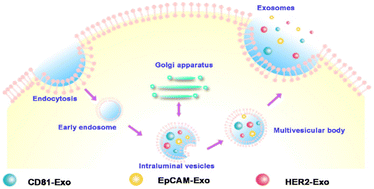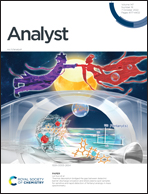Efficient exosome subpopulation isolation and proteomic profiling using a Sub-ExoProfile chip towards cancer diagnosis and treatment†
Abstract
Exosomes have been extensively studied as liquid biopsy biomarkers in the past decade. However, the origin and molecular heterogeneity of exosomes hinder the research development moving from proof-of-concept to clinical applications. Herein, we report an integrated microfluidic platform termed Sub-ExoProfile chip, to achieve the selective isolation and subsequent proteomic profiling of multiplex exosome subpopulations simultaneously. The Sub-ExoProfile chip comprises three cylindrical self-assembled nanopillars, on which specific exosome capture antibodies (CD81, EpCAM, HER2) were immobilized to capture and sort different exosome subpopulations. It is worth noting that the 3D porous nanopillars afford enhanced interface binding efficiency; thus, a tumor-specific exosome subpopulation with lowly-expressed surface marker was still isolated with satisfactory capture efficiency. Moreover, the amphiphilic mesoporous silica nanoparticle self-assembled nanopillars also served as a nanoreactor for the enrichment and in situ digestion of exosomal proteins, providing improved performance for the mass-spectrometry based molecular characterization of exosome subpopulations. The Sub-ExoProfile chip was investigated on standard exosome samples from different breast cancer cell lines. The isolation and quantitative detection of exosome subpopulations were in line with the molecular subtype of breast cancer cell lines, and the molecular makeup was confirmed using classic microplate ELISA. Clinical samples from HER2-positive and triple-negative breast cancer patients were also examined using the Sub-ExoProfile chip. The quantitative results of three exosome subpopulations distinguished the three subtypes of breast cancer significantly. Most importantly, the molecular characterization of three exosome subpopulations revealed that the distinct exosome subpopulation participated in a different signaling pathway and performed distinct biological functions. It is envisioned that the analysis of the exosome subpopulation on the Sub-ExoProfile chip will facilitate the screening of tumor-specific exosomal biomarkers and open a new avenue for exosome-based liquid biopsy.

- This article is part of the themed collection: Analyst HOT Articles 2022


 Please wait while we load your content...
Please wait while we load your content...